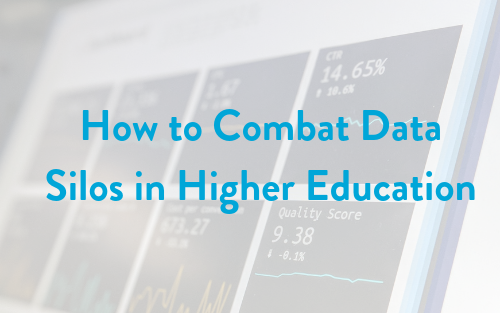At every higher education institution, you’ll find an abundance of data around student success, course feedback, program success, and more. However, there’s one issue that frequently acts as a major roadblock to finding insights from that data: it’s not all in one place. Data at higher education institutions is often stored on a departmental level and in a variety of different platforms. Because of this, data that may be crucial to understanding the impact of a program or an underlying trend may never be shared.
When data silos occur, it creates duplicate data, duplicate efforts, and duplicate costs — all of which are harmful to an institution’s success. Fragmented data across campus blocks higher education professionals from being able to see a holistic view of the student, which prevents them from being able to make informed decisions around resource allocation and programs.
To solve this problem, we looked at five steps that higher education institutions are taking to combat data silos, allowing them to draw meaningful conclusions and make data-driven decisions that impact the bottom line.
- Take an inventory of current platforms
Higher education institutions, along with many other industries, often find themselves acquiring new software licenses for every different need.
An annual review of current software platforms should be on every institutions best practice list. By keeping track of data sources, it will be easier to streamline and identify a central system and format for the future. An audit will also allow you to understand where data needs to be updated, and which data should be considered the single source of truth.
When evaluating new software, a key priority should be interoperability, the ability of different information systems or applications to connect and communicate with each other readily. When University of Kentucky began planning a single data analytics architecture, they found that they had 22 different systems from multiple software vendors. By identifying similarities between systems, like the fact that their financial and ERP systems are both SAP-based, it was able to develop a plan for its centralized data architecture.
- Identify areas to streamline
Once you’ve taken an inventory of what current platforms are being utilized on campus, you can start to look at what type of data each platform is storing. You may find that some softwares are storing or analyzing the same data, which could be an opportunity to streamline into one system. After your audit, you may also find software that you are not utilizing, and either make key stakeholders aware of the software and its data, or choose to cancel in an effort to centralize platforms.
The University of Denver brought together data from its course evaluations and its faculty activity reporting through Watermark to help inform the annual review process for faculty. By doing so, they are able to leverage their course evaluation data more effectively and make more informed decisions.
Your audit may also uncover a need that your current software providers or platforms are fulfilling. For example, University of Notre Dame found that it struggled to access data from its in-house data warehouse, a common issue among higher education institutions. In order to make the data more accessible, it brought on Tableau, a business intelligence tool, to create a campus-wide data portal that was much easier to use, interactive, and faster than its previous data portal.
- Improve user experience
Centralizing access to data is a proven way to improve user experience, which can then make it easier for staff and faculty to integrate data into every decision they make. Features like single sign-on (SSO) have become increasingly popular over the past few years due to safety benefits and a streamlined user experience. By simply making it quicker to access multiple systems, data immediately becomes more accessible.
Some higher ed institutions are taking it a step further and integrating data into a single dashboard. For example, Coppin State University is utilizing Blackboard Analytics to “democratize” data to make the same information available to all employees. After it implemented a centralized dashboard, it saw an increase in faculty outreach to students. Similarly, Santa Barbara City College built a campus-wide dashboard to help staff better understand how students course schedules impact grades and graduation rates.
- Focus on digestible data
The amount of data that a higher education institution holds can be endless. It can be easy to get lost in data and go down tangential pathways when trying to draw conclusions from data. If you bring staff and faculty a “data dump” of survey data, course performance, and student success metrics, it can be very overwhelming.
Indiana University Southeast found that by scheduling monthly meetings to review and discuss specific reports, it was able to break down data into manageable pieces. For example, by focusing on only recent alumni survey data in a meeting, campus leaders can ask questions and process the data so they can draw meaningful insights, rather than being overwhelmed with a multitude of different data points.
Try mapping out the agenda for the next six months of what you’d like to cover in each meeting. The different topics could relate to new data (for example, if new survey results just came in), or they could align with decision deadlines, like reviewing recruitment data before planning the recruitment strategy for the upcoming year.
- Training and continuing education
Without proper context, data is meaningless. Training staff and faculty on how to process and use data is crucial to allowing them to make impactful decisions.
In addition, it’s important to make staff and faculty aware of what data is available to them and how they can work with other departments to create a more holistic view of the problems they are trying to solve, like student success or retention rates. One recent study found that data often isn’t shared because individual departments fear a loss of power or believe their data will be misused. By holding monthly “lunch and learns”, institutions can bring together professionals across campus to provide a friendly atmosphere to foster sharing and build trust among colleagues. When planning cross-departmental meetings like this, be sure to keep the data digestible with a focused topic and data set.
If you are rolling out a new dashboard, like Santa Barbara City College’s example above, staff and faculty should be properly trained on how to utilize it. An online orientation module, utilizing video tutorials, can be a great way to ensure staff and faculty are properly trained on any new data initiatives.






